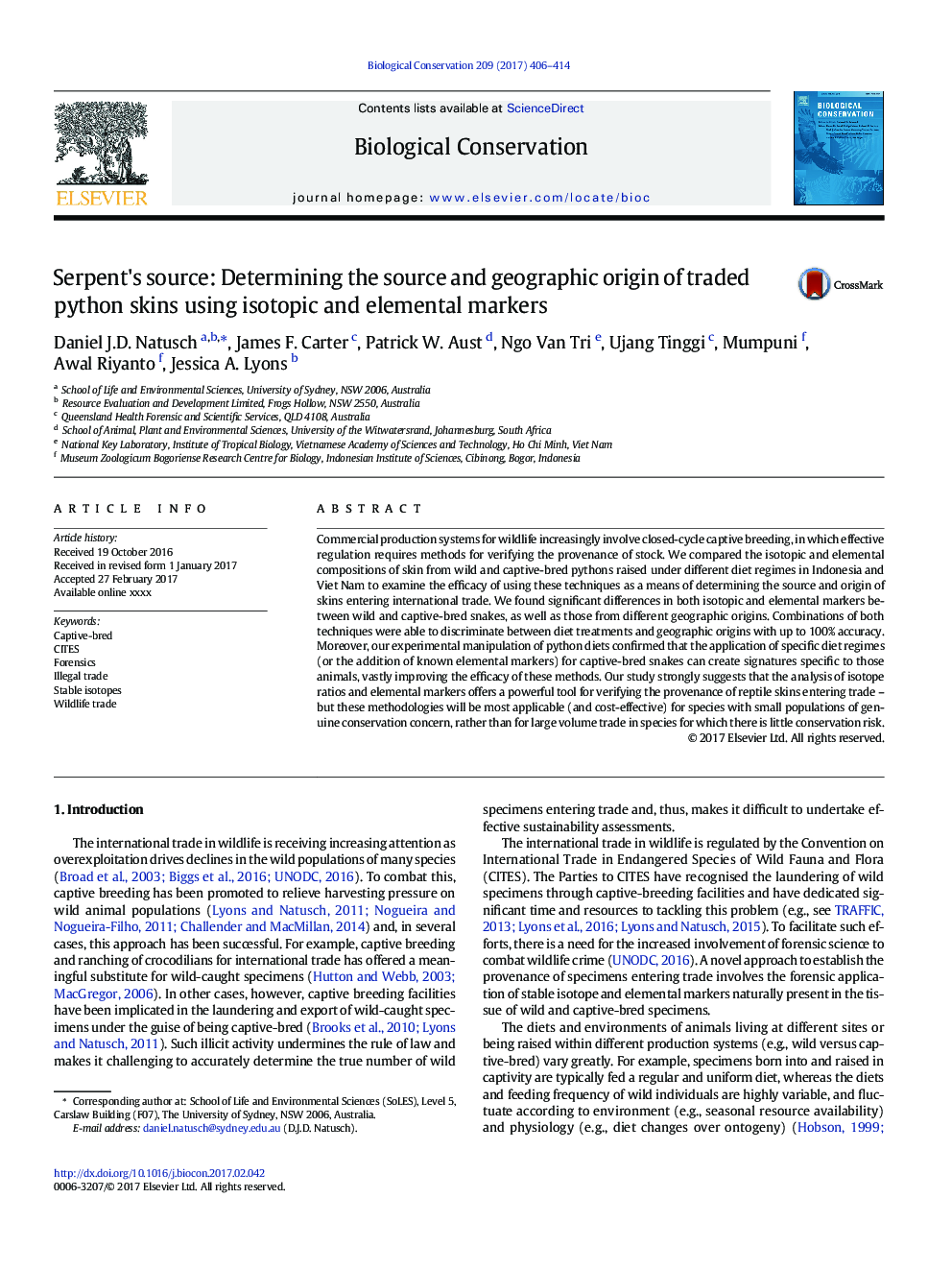| کد مقاله | کد نشریه | سال انتشار | مقاله انگلیسی | نسخه تمام متن |
|---|---|---|---|---|
| 5743343 | 1617893 | 2017 | 9 صفحه PDF | دانلود رایگان |
عنوان انگلیسی مقاله ISI
Serpent's source: Determining the source and geographic origin of traded python skins using isotopic and elemental markers
ترجمه فارسی عنوان
منبع خشونت: تعیین منبع و جغرافیایی پوسته معروف با استفاده از نشانگرهای ایزوتوپ و عنصر
دانلود مقاله + سفارش ترجمه
دانلود مقاله ISI انگلیسی
رایگان برای ایرانیان
کلمات کلیدی
ترجمه چکیده
سیستم های تولید تجاری برای حیات وحش به طور فزاینده ای شامل پرورش اساتید بسته است، که در آن مقررات موثر نیاز به روش هایی برای تأیید پروانه سهام دارد. ما ترکیبات ایزوتوپ و عنصری پوست را از پایتون های وحشی و اسیر یافته ای که تحت رژیم های مختلف رژیم غذایی در اندونزی و ویتنام مطرح شده اند، برای مقایسه اثربخشی استفاده از این تکنیک ها به عنوان وسیله تعیین منبع و منشا پوست های وارد شده در تجارت بین المللی مقایسه کردیم. ما در بین نشانگرهای ایزوتوپ و عنصری بین مارها وحشی و اسیر انحصاری، و نیز کسانی که از ریشه های مختلف جغرافیایی متفاوت بودند، اختلاف معنی دار داشتیم. ترکیبات هر دو تکنیک قادر به تشخیص بین درمان رژیم غذایی و ریشه های جغرافیایی با دقت 100٪ بود. علاوه بر این، تجربیات تجربی ما در مورد رژیم های پیتون تایید کرده اند که استفاده از رژیم های غذایی خاص (یا اضافه کردن مارکر های شناخته شده شناخته شده) برای مارهای اسیر بازدارنده می تواند امضاهای خاصی برای این حیوانات ایجاد کند، که به طور قابل توجهی بهبود کارایی این روش ها است. مطالعه ما به شدت نشان می دهد که تجزیه و تحلیل نسبت ایزوتوپ ها و نشانگرهای عناصر یک ابزار قدرتمندی برای تأیید پروانه پوسته خزنده در حال وارد شدن به تجارت ارائه می دهد اما این روش ها برای گونه های با جمعیت کوچکی از نگرانی های حفاظت واقعی مورد استفاده (و مقرون به صرفه) به جای تجارت بزرگ در گونه هایی که ریسک حفاظت کمی وجود دارد.
موضوعات مرتبط
علوم زیستی و بیوفناوری
علوم کشاورزی و بیولوژیک
بوم شناسی، تکامل، رفتار و سامانه شناسی
چکیده انگلیسی
Commercial production systems for wildlife increasingly involve closed-cycle captive breeding, in which effective regulation requires methods for verifying the provenance of stock. We compared the isotopic and elemental compositions of skin from wild and captive-bred pythons raised under different diet regimes in Indonesia and Viet Nam to examine the efficacy of using these techniques as a means of determining the source and origin of skins entering international trade. We found significant differences in both isotopic and elemental markers between wild and captive-bred snakes, as well as those from different geographic origins. Combinations of both techniques were able to discriminate between diet treatments and geographic origins with up to 100% accuracy. Moreover, our experimental manipulation of python diets confirmed that the application of specific diet regimes (or the addition of known elemental markers) for captive-bred snakes can create signatures specific to those animals, vastly improving the efficacy of these methods. Our study strongly suggests that the analysis of isotope ratios and elemental markers offers a powerful tool for verifying the provenance of reptile skins entering trade - but these methodologies will be most applicable (and cost-effective) for species with small populations of genuine conservation concern, rather than for large volume trade in species for which there is little conservation risk.
ناشر
Database: Elsevier - ScienceDirect (ساینس دایرکت)
Journal: Biological Conservation - Volume 209, May 2017, Pages 406-414
Journal: Biological Conservation - Volume 209, May 2017, Pages 406-414
نویسندگان
Daniel J.D. Natusch, James F. Carter, Patrick W. Aust, Ngo Van Tri, Ujang Tinggi, Mumpuni Mumpuni, Awal Riyanto, Jessica A. Lyons,
